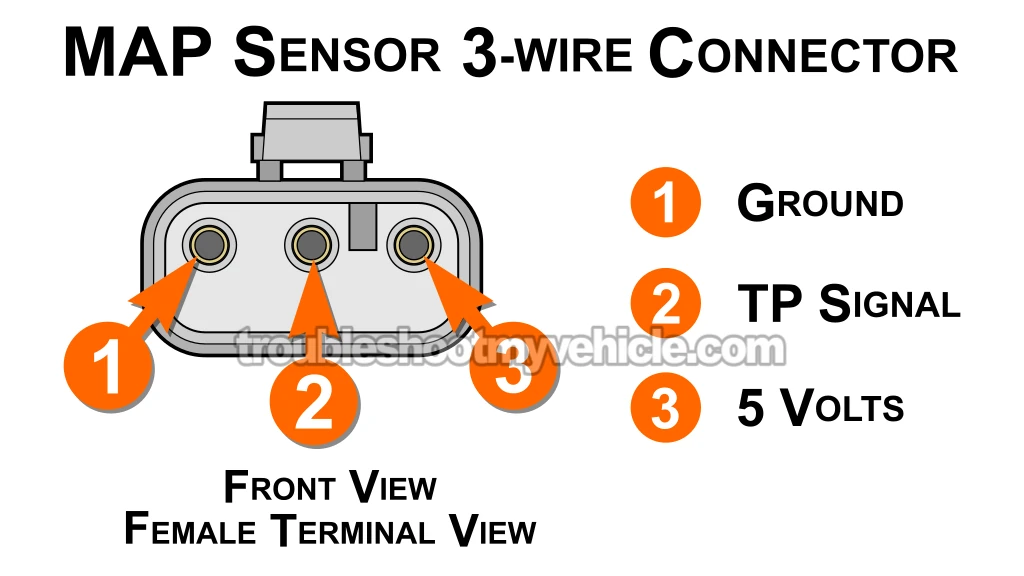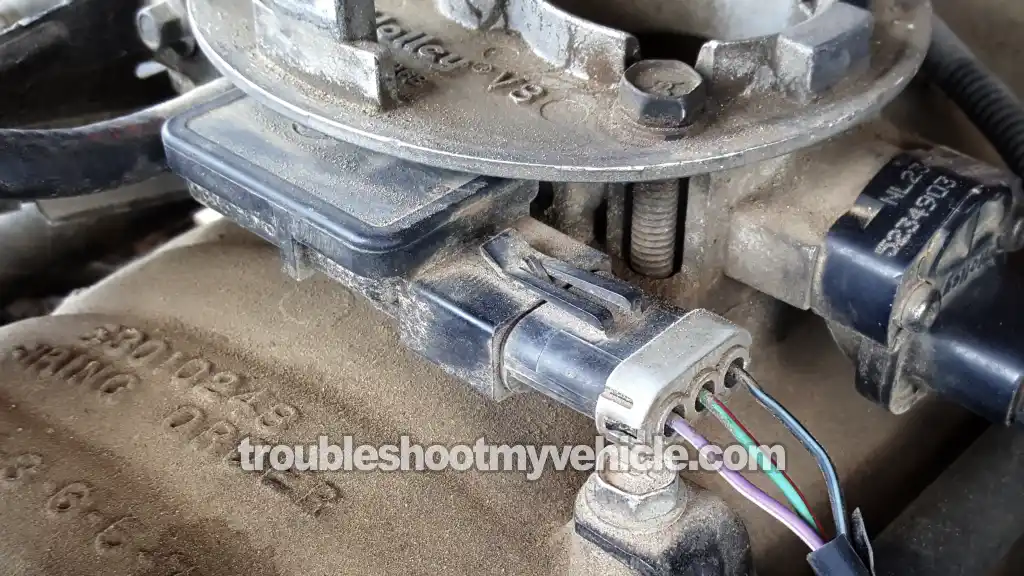
The manifold absolute pressure (MAP) sensor can be very accurately tested with a multimeter to see if it's bad or not without removing it (no scan tool required).
In this tutorial, I'll show you just how in a step-by-step manner. You'll also be able to diagnose the following manifold absolute pressure (MAP) sensor diagnostic trouble codes: Code 14 (OBD-II -1992-1995) or P0107/P0108 (OBD-II -1996).
Contents of this tutorial:
- Symptoms Of A Bad MAP Sensor.
- Basics Of The Manifold Absolute Pressure (MAP) Sensor.
- MAP Sensor 3-Wire Connector Pinout.
- Where To Buy The MAP Sensor And Save.
- TEST 1: Checking The MAP Sensor Signal.
- TEST 2: Making Sure The MAP Sensor Is Getting Power.
- TEST 3: Making Sure The MAP Sensor Is Getting Ground.
- MAP Sensor Code Won't Go Away.
- More 5.2L, 5.9L Dodge Ram Diagnostic Tutorials.
APPLIES TO: This tutorial applies to the following vehicles (since they use the exact same manifold absolute pressure sensor):
- 5.2L, 5.9L V8 Dodge Ram 150 Pickup: 1992, 1993.
- 5.2L, 5.9L V8 Dodge Ram 250 Pickup: 1992, 1993.
- 5.9L V8 Dodge Ram 350 Pickup: 1992, 1993.
- 5.2L, 5.9L V8 Dodge Ram 1500 Pickup: 1994, 1995, 1996.
- 5.2L, 5.9L V8 Dodge Ram 2500 Pickup: 1994, 1995, 1996.
- 5.2L, 5.9L V8 Dodge Ram 2300 Pickup: 1994, 1995, 1996.
OTHER MAP SENSOR TEST TUTORIALS:
- How To Test The MAP Sensor (1989-1990 5.2L, 5.9L V8 Dodge Ram Pickup).
- How To Test The MAP Sensor (1991 5.2L, 5.9L V8 Dodge Ram Pickup).
- How To Test The MAP Sensor -P0107, P0108 (1997-2003 5.2L, 5.9L V8 Dodge Ram Pickup).
3.9L V6 Dodge Ram Pickup MAP Sensor Tutorial:
V6 And V8 Dodge Ram Van MAP Sensor Tutorials:
- How To Test The MAP Sensor (1992-1997 3.9L V6 Dodge Ram Van).
- How To Test The MAP Sensor (1992-1997 5.2L, 5.9L V8 Dodge Ram Van).
Symptoms Of A Bad MAP Sensor
If the manifold absolute pressure (MAP) sensor fails, the check engine light (CEL) will illuminate, and you'll likely see one of the following diagnostic trouble codes pop up:
- OBD-I (1992–1995):
- Trouble Code 14: MAP Sensor Voltage Too Low (OBD-I, model years 1992 to 1995).
- Trouble Code 14: MAP Sensor Voltage Too High (OBD-I, model years 1992 to 1995).
- OBD-II (1996 and newer):
- P0107: MAP Sensor Voltage Too Low (OBD-II).
- P0108: MAP Sensor Voltage Too High (OBD-II).
In addition to setting a trouble code, your Dodge Ram V8 pickup may also show one or more of the following symptoms when the MAP sensor (or something that affects it) starts acting up:
- Rough idle: The engine runs unevenly, especially when idling in Drive (like while waiting at a stoplight).
- Black exhaust smoke: Noticeable black smoke from the tailpipe, particularly when you rev the engine.
- Stalling under load: The engine cuts out and dies when accelerating or under driving conditions.
- Immediate stall after starting: The engine starts up but dies right away before it can stay running.
- Lack of acceleration: The engine feels sluggish and unresponsive when trying to pick up speed.
While MAP sensor failures are pretty common, in some cases, something else is interfering with the sensor's signal, tricking the fuel injection system into thinking the MAP sensor is faulty. That's why it's important to run a MAP sensor test before jumping to replace it.
From my experience, the most reliable way to check if the MAP sensor is working properly is by bench testing it —and that's exactly what I'm going to walk you through in this article. Bench testing helps rule out other issues that may be throwing off the sensor's readings and sending incorrect data to the engine computer.
If after doing the MAP sensor test and the MAP sensor is good, then take a look at the section:
Basics Of The Manifold Absolute Pressure (MAP) Sensor

The fuel injection computer (known as the PCM - Powertrain Control Module in tech speak) uses the MAP sensor, the crankshaft position sensor (for engine RPM info), and the intake air temperature sensor to calculate how much air the engine is breathing in your Dodge Ram pickup.
Once the PCM knows how much air is entering the engine, it can now calculate the amount of fuel to inject into each cylinder to keep it running optimally and to keep it within certain pollution standards.
How is this accomplished? In a nutshell, by measuring the amount of intake manifold vacuum and translating this measurement into a voltage signal.
This voltage signal either decreases or decreases depending on the amount of vacuum (produced within the intake manifold) and is sent to the PCM on the dark green with red stripe (DK GRN/RED) wire of the 3-wire MAP sensor connector.
Briefly, the two things you need to keep in mind are:
- Under load when the amount of intake manifold vacuum is high (like when you're accelerating the engine to move your pickup from a stand-still, stop, red light, etc.), the MAP sensor produces a decreasing MAP voltage signal.
- When the engine is under no load and the amount of engine manifold vacuum is low (like when you're waiting for the red light to turn green and your pickup's engine is idling), the MAP sensor produces an increasing MAP voltage signal.
The key to troubleshooting the MAP sensor is to see (with a multimeter) whether this MAP voltage signal actually does increase/decrease as you manually apply vacuum to the MAP sensor's vacuum inlet port (and that's exactly what we'll do in this tutorial).
MAP Sensor 3-Wire Connector Pinout

In the table below, you'll find a short description of what each wire does:
| 1992-1996 MAP Sensor Circuits | ||
|---|---|---|
| Pin | Wire Color | Description |
| 1 | BLK/LT BLU | Sensor Ground |
| 2 | DK GRN/RED | MAP Signal |
| 3 | VIO/WHT | 5 Volts |
Where To Buy The MAP Sensor And Save
You can buy the MAP sensor for your Dodge Ram pickup in just about any auto parts store but you'll spend a whole lot more because they mark it up quite a bit.
My suggestion is to buy it online or at least comparison shop to get an idea of how much it costs and how much you can save.
The following links:
Disclosure: As an Amazon Associate, I earn from qualifying purchases. If my tutorials help you, using these links is an easy way to support the site at no extra cost to you. Thank you!
TEST 1: Checking The MAP Sensor Signal
What usually happens, when the MAP sensor fails, is that it just simply stops creating a MAP sensor signal.
To be a bit more specific, it stops measuring the amount of intake manifold vacuum as the engine runs and produces a ‘fixed’ voltage signal or none at all (remember, this voltage signal has to vary depending on the amount of vacuum within the intake manifold).
The cool thing is that you and I can tap into the dark green with red stripe (DK GRN/RED) wire with a multimeter and manually apply vacuum to the MAP sensor with a vacuum pump and see if the voltage signal decreases and then increases (as we apply/release vacuum).
This is a pretty easy test and I'll explain it all in a step-by-step manner in the test steps below.
IMPORTANT: The MAP sensor must remain connected to its harness connector to accomplish this test.
Here are the test steps:
- 1
Remove the MAP sensor from its place. Reconnect the MAP sensor to its engine wiring harness connector but leave the vacuum hose off.
NOTE: The MAP sensor connector needs to be connected to the sensor, so you'll need to either back-probe the connector or use a wire piercing probe to get to the signal inside the wire (to see what a wire piercing probe looks like: Wire Piercing Probe Tool). - 2
Place your multimeter in Volts DC mode and connect the red test lead to the DK GRN/RED wire of the MAP sensor harness connector (see image 1 of 2).
- 3
Ground the black multimeter test lead directly on the battery negative (-) post and turn the key to the On position (do not start the engine).
At this point your multimeter should read a voltage between 4.5 to 5 Volts DC. - 4
Manually apply vacuum with a vacuum pump to the MAP sensor's vacuum inlet port using a suitable vacuum hose.
NOTE: If you don't have a vacuum pump, no problem. You can use your mouth to apply vacuum to the vacuum inlet port. - 5
The multimeter should show an decreasing voltage as you apply vacuum with the vacuum pump.
With about 20 in. Hg of vacuum applied, your multimeter should read about 1.1 to 1.7 Volts DC.
NOTE: If you're using your mouth to apply vacuum, and the MAP sensor is good, you won't be able to bring down the voltage down to 1 Volts (on lung power). The important thing is to see the voltage decrease when applying vacuum and seeing the voltage return to its original voltage when you release said vacuum.
Let's take a look at what your test results mean:
CASE 1: The voltage decreased and increased as you applied and released vacuum. This tells that the MAP sensor on your Dodge Ram IS NOT defective.
Since the MAP sensor is creating an increasing/decreasing voltage signal on the DK GRN/RED wire, this test result also says that:
- The MAP sensor is getting power on the VIO/WHT wire of its harness connector.
- The MAP sensor is getting Ground on the BLK/LT BLU wire of its harness connector.
CASE 2: The voltage DID NOT increase or decrease. This test result usually means that the MAP sensor on your Dodge Ram is bad and needs to be replaced.
Before replacing the MAP sensor, I suggest that you verify that it's getting power and Ground. Your next test is to make sure it's getting power. For this test go to: TEST 2: Making Sure The MAP Sensor Is Getting Power.




